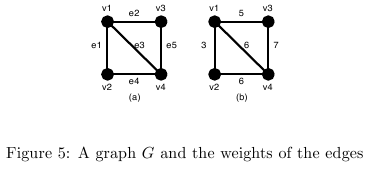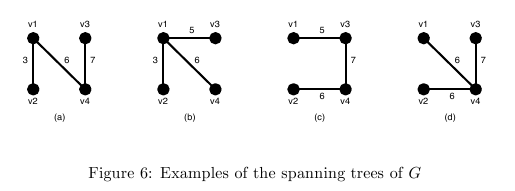UVA - 1395 Slim Span
2015-03-21 01:26
316 查看
Slim Span
Submit Status
Description

Given an undirected weighted graph G , you should find one of spanning trees specified as follows.
The graph G is an ordered pair (V, E) , where V is
a set of vertices {v1, v2,..., vn} and E is a set of undirected
edges {e1, e2,..., em} . Each edgee

E has
its weight w(e) .
A spanning tree T is a tree (a connected subgraph without cycles) which connects all the n vertices
with n - 1 edges. The slimness of a spanning tree T is defined as the
difference between the largest weight and the smallest weight among the n - 1 edges of T .

For example, a graph G in Figure 5(a) has four vertices {v1, v2, v3, v4} and
five undirected edges {e1, e2, e3, e4, e5} . The weights
of the edges are w(e1) = 3 , w(e2) = 5 , w(e3)
= 6 , w(e4) = 6 , w(e5) = 7 as shown in Figure 5(b).
=6in

There are several spanning trees for G . Four of them are depicted in Figure 6(a)∼(d). The spanning tree Ta in
Figure 6(a) has three edges whose weights are 3, 6 and 7. The largest weight is 7 and the smallest weight is 3 so that the slimness of the tree Ta is 4. The slimnesses of spanning trees Tb , Tc and Td shown
in Figure 6(b), (c) and (d) are 3, 2 and 1, respectively. You can easily see the slimness of any other spanning tree is greater than or equal to 1, thus the spanning tree Td in Figure
6(d) is one of the slimmest spanning trees whose slimness is 1.
Your job is to write a program that computes the smallest slimness.
nm
a1b1w1

ambmwm
Every input item in a dataset is a non-negative integer. Items in a line are separated by a space.
n is the number of the vertices and m the number of the edges. You can assume 2

n

100 and 0

m

n(n -
1)/2 . ak and bk(k = 1,..., m) are
positive integers less than or equal to n , which represent the two vertices vak and vbk connected
by the k -th edge ek . wk is a positive integer less
than or equal to 10000, which indicates the weight of ek . You can assume that the graph G = (V, E) is
simple, that is, there are no self-loops (that connect the same vertex) nor parallel edges (that are two or more edges whose both ends are the same two vertices).
Sample
Sample
| Time Limit: 3000MS | Memory Limit: Unknown | 64bit IO Format: %lld & %llu |
Description

Given an undirected weighted graph G , you should find one of spanning trees specified as follows.
The graph G is an ordered pair (V, E) , where V is
a set of vertices {v1, v2,..., vn} and E is a set of undirected
edges {e1, e2,..., em} . Each edgee

E has
its weight w(e) .
A spanning tree T is a tree (a connected subgraph without cycles) which connects all the n vertices
with n - 1 edges. The slimness of a spanning tree T is defined as the
difference between the largest weight and the smallest weight among the n - 1 edges of T .

For example, a graph G in Figure 5(a) has four vertices {v1, v2, v3, v4} and
five undirected edges {e1, e2, e3, e4, e5} . The weights
of the edges are w(e1) = 3 , w(e2) = 5 , w(e3)
= 6 , w(e4) = 6 , w(e5) = 7 as shown in Figure 5(b).
=6in

There are several spanning trees for G . Four of them are depicted in Figure 6(a)∼(d). The spanning tree Ta in
Figure 6(a) has three edges whose weights are 3, 6 and 7. The largest weight is 7 and the smallest weight is 3 so that the slimness of the tree Ta is 4. The slimnesses of spanning trees Tb , Tc and Td shown
in Figure 6(b), (c) and (d) are 3, 2 and 1, respectively. You can easily see the slimness of any other spanning tree is greater than or equal to 1, thus the spanning tree Td in Figure
6(d) is one of the slimmest spanning trees whose slimness is 1.
Your job is to write a program that computes the smallest slimness.
Input
The input consists of multiple datasets, followed by a line containing two zeros separated by a space. Each dataset has the following format.nm
a1b1w1

ambmwm
Every input item in a dataset is a non-negative integer. Items in a line are separated by a space.
n is the number of the vertices and m the number of the edges. You can assume 2

n

100 and 0

m

n(n -
1)/2 . ak and bk(k = 1,..., m) are
positive integers less than or equal to n , which represent the two vertices vak and vbk connected
by the k -th edge ek . wk is a positive integer less
than or equal to 10000, which indicates the weight of ek . You can assume that the graph G = (V, E) is
simple, that is, there are no self-loops (that connect the same vertex) nor parallel edges (that are two or more edges whose both ends are the same two vertices).
Output
For each dataset, if the graph has spanning trees, the smallest slimness among them should be printed. Otherwise, `-1' should be printed. An output should not contain extra characters.Sample
Input
4 5 1 2 3 1 3 5 1 4 6 2 4 6 3 4 7 4 6 1 2 10 1 3 100 1 4 90 2 3 20 2 4 80 3 4 40 2 1 1 2 1 3 0 3 1 1 2 1 3 3 1 2 2 2 3 5 1 3 6 5 10 1 2 110 1 3 120 1 4 130 1 5 120 2 3 110 2 4 120 2 5 130 3 4 120 3 5 110 4 5 120 5 10 1 2 9384 1 3 887 1 4 2778 1 5 6916 2 3 7794 2 4 8336 2 5 5387 3 4 493 3 5 6650 4 5 1422 5 8 1 2 1 2 3 100 3 4 100 4 5 100 1 5 50 2 5 50 3 5 50 4 1 150 0 0
Sample
Output
1 20 0 -1 -1 1 0 1686 50
#include<iostream>
#include<cstring>
#include<string>
#include<algorithm>
#include<cstdio>
using namespace std; //要求生成树边的最大权值与最小权值之间的差最小
//思路是枚举各个生成树,边排序,在按最小边从边1开始,依次递增,最后得到答案。
const int mxe = 5000;
const int mnx = 120;
const int INF = 10000000;
struct edge
{
int u, v, c;
bool operator < (const edge &b) const
{
return c < b.c;
}
}e[mxe];
int n, m;
int l;
int fa[mnx];
int find(int x)
{
if (fa[x] != x) fa[x] = find(fa[x]);
return fa[x];
}
// kruskal 复杂度O(|E|log|E|), |E|:边数
int kruskal()
{
int max;
for (int i = 1; i <= n; ++i)
fa[i] = i; //并查集初始化
int tt = 0;
int i;
for (i = l; i <= m; ++i) //改变最小边
{
int u = e[i].u, v = e[i].v, c = e[i].c;
u = find(u), v = find(v);
if (u != v)
{ //不在同一个集合里面
fa[u] = v;
tt++;
max = e[i].c;
}
}
if (tt == n - 1) return max;
else return 0;
}
int main()
{
while (scanf("%d%d",&n,&m)!=EOF)
{
if (n == 0) break;
int u, v, w;
for (int i = 1; i <= m; i++)
{
scanf("%d%d%d",&u,&v,&w);
e[i].u = u;
e[i].v = v;
e[i].c = w;
}
sort(e + 1, e + m + 1); // 边排序
int min = INF;
int ans=INF, ans1, max;
for (l = 1; l <= m; l++) //枚举
{
max=kruskal();
if (!max) continue;
ans1 = max - e[l].c;
if (ans1 < ans) ans = ans1;
}
if (ans == INF) cout << -1 << endl;
else cout << ans << endl;;
}
}
相关文章推荐
- UVA - 1395 Slim Span(最小生成树)
- uva1395 Slim Span
- UVA-1395 Slim Span
- Uva1395——Slim Span
- UVA-1395 Slim Span
- UVa 1395 slim span
- UVA - 1395 Slim Span
- UVA 1395 Slim Span
- (beginer) 最小生成树 UVA 1395 Slim Span
- Uva 1395 Slim Span
- UVA 1395 Slim Span 最小生成树
- UVA 1395 Slim Span
- UVA 1395 Slim Span
- UVA 1395 Slim Span
- UVa 1395 (最小生成树) Slim Span
- UVA 1395 Slim Span
- UVa 1395 Slim Span
- uva 1395 Slim Span
- 【UVA】1395-Slim Span
- UVa 1395 Slim Span
